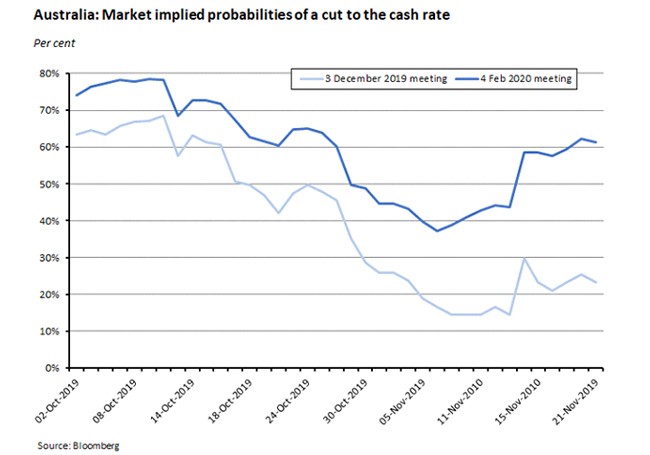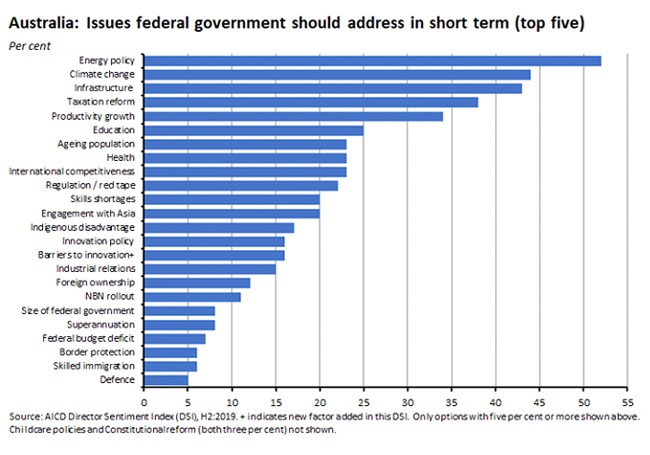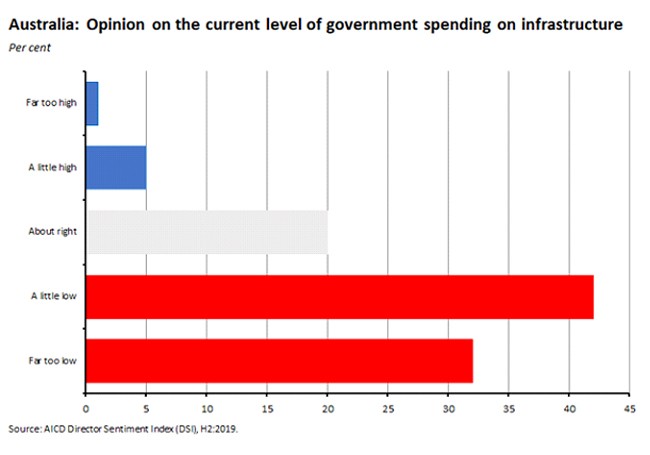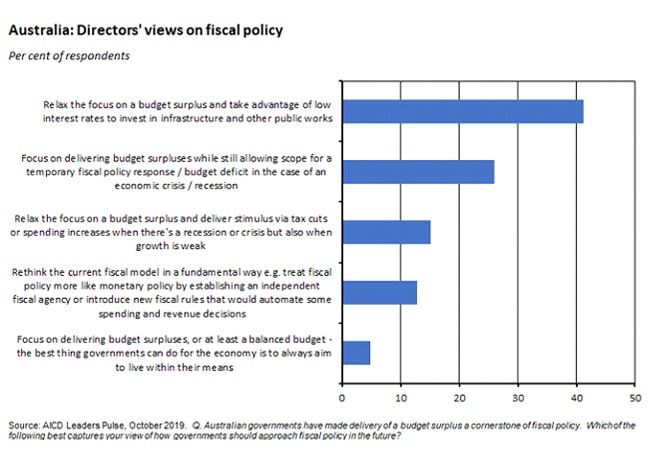No major Australian data releases this week, but the minutes from the last RBA Board Meeting revealed that policymakers had contemplated another rate cut at the 5 November meeting despite some qualms about the impact of lower rates
The government announced that it was bringing forward some infrastructure spending but also reaffirmed its commitment to delivering a budget surplus. This week’s readings include the shifting economic performance of the states, the scope for a productivity revolution in Australia’s human services, how low bond yields are creating a global pension crisis, how the US is triggering a crisis for the WTO, and a critique of economics and economists (plus some rebuttals).
What I have been following in Australia…
What happened:
The RBA published the minutes of the 5 November monetary policy meeting. They report that ‘members observed that while the outlook for the global economy remained reasonable, the risks continued to be tilted to the downside...The outlook for the Australian economy was little changed since August. After a soft period in the second half of 2018, GDP growth had picked up a little in the first half of 2019 and it appeared that a gentle turning point had been reached…Over time, inflation was expected to increase gradually in response to some tightening in labour market conditions, to be close to 2 per cent in 2020 and 2021.’
Given this context, the minutes continue, ‘The Board agreed that a case could be made to ease monetary policy at this meeting, but that the most appropriate approach would be to maintain the current stance of monetary policy and to make another full assessment once more evidence of the effects of the earlier monetary easing had become available.’
The case for another cut to the cash rate ‘largely rested on only gradual progress having been made towards the Bank's goals’ but the Board also debated the continued efficacy of further rate cuts, with the minutes noting that although ‘members judged that lower interest rates were supporting the economy through the usual transmission channels (including a lower exchange rate, higher asset prices and higher cash flows for borrowers), they recognised the negative effects of lower interest rates on savers and confidence. They also discussed the possibility that a further reduction in interest rates could have a different effect on confidence than in the past, when interest rates were at higher levels.’
The minutes conclude with the familiar comment – in what is a soft form of open-ended forward guidance1 – that it would be ‘reasonable to expect that an extended period of low interest rates would be required’ and that the RBA remained ‘prepared to ease monetary policy further if needed to support sustainable growth in the economy, full employment and the achievement of the inflation target over time.’
Why it matters:
Readers will remember that in the lead up to November’s Board meeting there had been a strong consensus that the RBA would leave the cash rate unchanged: none of the 30 economists surveyed beforehand by Bloomberg had predicted a cut and financial markets had put the probability of a reduction in the cash rate at less than five per cent.
In that context, the news that the Board had been actively considering the case for a rate cut in November prompted some market re-assessment of the future policy stance, with a small but sharp drop in the Australian dollar immediately following publication of the minutes. Over the course of October, markets had become increasingly cautious about the prospect of further rate cuts from the RBA, scaling back the likelihood of rate cuts this year and next. This month has seen that sentiment shift again, with last week’s disappointing labour market report and the soft wage numbers that preceded it working to change some minds. The tone of the minutes also reinforces the impression that the case for the RBA to do more to hit its inflation and full employment objectives remains intact. There has now been a modest increase in the market probability of a rate cut at the 3 December Board meeting (still only around 22 per cent at the time of writing) and in February (now at around 62 per cent).

Of course, that case is complicated by the already low level of the cash rate, which means both that the RBA is running out of conventional ammunition and that the Board is increasingly mindful of some of the potential negative effects of extremely low rates. It’s that complication that is driving continued market chatter about the possibility of the central bank turning to unconventional measures such as quantitative easing next year. Next Tuesday’s speech by RBA Governor Phillip Lowe on Unconventional Monetary Policy: Some Lessons from Overseas should provide a useful update on the central bank’s thinking in this regard.
What happened:
Prime Minister Scott Morrison said in a speech to the Business Council of Australia (BCA) that the government would fast-track $3.8 billion of infrastructure spending over the next four years, including $1.8 billion in the next two years. Together with additional drought relief spending and around $7.2 billion in tax cuts in the form of the Low and Middle Income Tax Offset (LMITO), Morrison calculated that since the May election, Canberra will have provided around $9.5 billion of additional fiscal support to the economy ‘this year and next year’. The Prime Minister argued that a ‘panicked reaction to contemporary challenges…would amount to a serious misdiagnosis of our economic situation’ and subsequently emphasised that balancing the fiscal books was ‘critically important for Australia’s future financial resilience’ given that the Australian economy was ‘facing headwinds not just now…but for years to come’.
Morrison’s defence of the government’s fiscal strategy was echoed in comments made earlier in the week by Treasurer Josh Frydenberg, who argued that the government’s focus on delivering a budget surplus was important not only to cope with current demands but also to meet long-term challenges including the ‘economic time bomb’ of an ageing population.
Why it matters:
The RBA’s decision to drive the cash rate down to record lows has prompted a debate as to the appropriate stance of fiscal policy. At a time when conventional monetary stimulus is being pushed close to its limit, does it make sense for the government’s fiscal policy strategy to remain focussed on delivering a budget surplus, or should fiscal policy join monetary policy in delivering more stimulus to the economy? RBA governor Phillip Lowe has been relatively clear on this point, arguing that ‘if further stimulus to demand growth is required to get us to full employment and closer to the economy's capacity, monetary policy is not the country's only option. Monetary policy certainly can help, and it is helping, but there are certain downsides from relying too much on monetary policy. One option is for fiscal support, including through spending on infrastructure. Spending on infrastructure not only adds to demand in the economy but, done properly, it can boost the economy's productivity...There is no shortage of finance to do this, with interest rates the lowest they have ever been.’
Along with boosting infrastructure spending, a range of economists, businesspeople and commentators have suggested several other fiscal policy options, including for the government to bring forward the second stage of its tax package, currently scheduled to kick in from July 2022, and the introduction of an investment allowance.
As noted a couple of weeks ago, the results of our latest survey of Directors Sentiment (the DSI) look to be broadly consistent with at least the infrastructure component of the case for fiscal policy to do more. For example, Directors ranked infrastructure behind only energy policy and climate change in terms of short-term government priorities.

Directors also continue to think that current levels of infrastructure spending are too low:

Similarly, in our October Leaders’ Pulse survey, the most popular fiscal policy option selected by our respondents from the menu on offer was for Canberra to relax its focus on delivering a budget surplus and take advantage of low interest rates to invest in infrastructure.

The response from the Prime Minister this week suggests that although the government is mindful of the case for more – and especially more timely – infrastructure spending, it continues to balance this against its political and economic desire to move the budget into surplus. There’s also an understandable reluctance to send an adverse signal about the current health of the economy.
It’s in the context of that balancing act that the Prime Minister claimed this week that ‘a panicked reaction to contemporary challenges…would amount to a serious misdiagnosis of our economic situation’ and argued that achieving a surplus was not just a political/symbolic measure, but also had an economic rationale, emphasising that the ‘point of a surplus, is to pay down our debt…we can increase our resilience for the future.’ At the same time, by announcing an acceleration in infrastructure spending, Canberra is also hoping to signal that it is not standing idly by at a time when the economy is looking quite soft (and thereby conceding, at least implicitly, that there is indeed a case for a step up in fiscal action). For now, however, the message from Canberra is that any hopes for additional fiscal measures such as accelerated tax cuts or a new investment allowance look like they will have to wait at least until next year’s budget.
With respect to the case for building up the budget to increase financial resilience, there’s an interesting parallel here with the RBA’s discussion at the time of the October Board meeting as to whether some monetary stimulus should be kept in reserve to deal with any future negative shocks. The RBA Board’s conclusion then was that it was best not to wait, as ‘the Board could reduce the likelihood of a negative shock leading to outcomes that materially undershot the Bank's goals by strengthening the starting point for the economy.’
If the RBA’s forecast that the economy has passed a ‘gentle turning point’ turns out to be on the money, then the decision to hold off on any big fiscal stimulus moves will be viewed in retrospect as a prudent one. But if the economy were to weaken further, that same choice will look instead like a political gamble that failed to pay off.
What I’ve been reading: articles and essays
ANZ’s Stateometer shows growth in half of Australia’s states and territories moved from deceleration to acceleration in the three months to September this year, with only Victoria and South Australia still decelerating. On the other hand, South Australia and the ACT were the only regions to record above trend growth over the same period.
RBA Deputy Governor Guy Debelle delivered some remarks on mortgage arrears, a key indicator of household financial health. He noted that at just one per cent, the current arrears rate ‘is low by both historical and international standards’ (by way of comparison, during the GFC, US arrears peaked at around 10 per cent) and that Australia’s non-performing loan levels ‘currently pose little risk to the health of financial institutions.’ That said, arrears rates have been rising over recent years and are now at around a decade high, with some significant regional variation, with arrears highest in Western Australia (1.8 per cent) and the Northern Territory. Nationally, the RBA estimates that around 15 per cent of loans that are in arrears are also in negative equity, which is equivalent to just 0.1 per cent of all housing loans. The central bank’s analysis also suggests that there has been an improvement in the quality of lending, with loans originated in the past two years having an arrears rate almost 40 bp lower than loans originated prior to 2014. Debelle judges this shows that tighter lending standards have been effective.
The Treasurer spoke on the implications of China’s growth for Australia and the world.
The Productivity Commission’s Stephen King reckons that human services (loosely defined as covering Childcare, education and training; Justice; Emergency management; Health; Community services; and Housing and homeless, which – excluding housing – collectively account for about 20 per cent of GDP) will see ‘the next wave of productivity reform.’ He thinks that broad reforms to human services could potentially deliver gains akin to those estimated for National Competition Policy reform – a long run annual gain in real GDP of 5.5 per cent.
Two Big Reads from the FT: One on the global pension crisis sparked by the collapse in international bond yields and one on the prospect of a second ‘lost decade’ for Latin America as the combination of low growth and high inequality triggers a wave of social and political unrest.
A new IMF working paper tries to estimate the impact of a ‘managed trade’ arrangement between the United States and China in the form of trade diversion effects for other countries. The idea is that, to the extent that any future deal commits China to substantial purchases of US vehicles, machinery, electronics and commodities, then competing exporters will suffer. The estimates here suggest country export exposures to this kind of effect could range from three to four per cent of GDP in the case of Singapore and Malaysia and two to three per cent of GDP for South Korea to one per cent of GDP for advanced economies including Australia, Germany and Japan.
Steve Grenville reviews Paul Blustein on China, America and the fracturing of the global trading system (I first came across Blustein’s work in the form of The Chastening, his terrific book on the IMF and the Asian financial crisis. I would also recommend his book on Argentina).
A VoxEU column looks at the crisis facing the WTO dispute settlement system. The immediate source of danger is the United States’ policy of blocking the appointment of new members to the WTO’s Appellate Body (AB) as the terms of sitting members expire. As a result, by early next month there will only be one active member left, while a minimum of three AB members are required to consider any appeal of a WTO panel report. But the column’s authors also note that while no other WTO member supports the current US approach, concerns about the AB exceeding its mandate are not restricted to Washington.
Also from VoxEU: a look at how the presence of data sharing externalities can create inefficient and welfare-reducing outcomes in data markets.
David Graeber rails against economics: a discipline ‘no longer fit for purpose’ apparently, while economic theory ‘increasingly resembles a shed full of broken tools’. Ouch. For some rebuttals (sorry, but perhaps not surprisingly, I couldn’t resist), Noah Smith points out some of the problems with the piece while also admitting where Graeber has a point. See also this take down of Graeber’s first five paragraphs. And FT Alphaville critiques his claim that there is such a thing as a ‘magic money tree.’
Tyler Cowen on how technological progress creates new kinds of inflation inequality.
Greg Ip in the WSJ urges a cautious approach towards US plans to tax the ultra-wealthy, drawing on research that finds a correlation between billionaires per capita and income per capita.
Finally, another podcast from David Beckworth’s Macro Musings. This one is with Binayamin Applebaum on his new book, The Economists’ Hour: False Prophets, Free Markets and the Fracture of Society. From the discussion here, this is a more considered critique of the profession than Graeber’s one.
1 When a central bank provides forward guidance it means it is providing information about its future monetary policy intentions. Forward guidance can come in different varieties, with at least three types having been used in the recent past: open-ended forward guidance is a purely qualitative statement about the path for policy rate(s) (‘we expect rates to be low for an extended period of time’); data-based forward guidance sets out a policy path that is conditional on economic outcomes (‘rates will remain low for as long necessary to return inflation to a rate close to two per cent’); and calendar-based forward guidance (‘rates will remain at their present levels until the second half of next year’).
2 Note that (1) the sample size for the Leaders’ Pulse is much smaller than for the DSI and (2) the sample for the Pulse is not designed to replicate the DSI sample.
Latest news
Already a member?
Login to view this content


